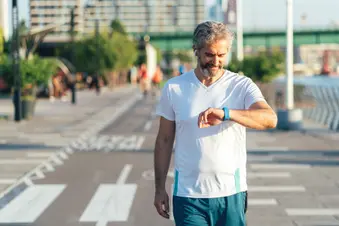
If you have obstructive sleep apnea (OSA), you’ll likely explore positive airway pressure (PAP), oral and dental appliances, or other treatment options.
But certain habits and changes in your everyday life can also support more restful snoozing. Doctors call these behavioral interventions. They’re actions you can take to boost your overall health and address specific issues you may have while snoozing. Here’s what you need to know.
Get to a Healthy Weight
Extra pounds not only worsen sleep apnea symptoms, sometimes they’re the cause. A narrow airway — often triggered by extra fat in that area — can make it harder to breathe while sleeping.
What’s healthy looks different for everyone and depends on age, sex, genes, and other factors. But shedding just 10% of your body weight can help. In some people, slimming down gets rid of sleep apnea altogether.
What you eat and drink are key factors when it comes to putting on the pounds. So try to choose whole foods over prepackaged, processed options. Do your best to prioritize eating:
- Fruits
- Vegetables
- Whole grains
- Lean proteins
Try to avoid or at least cut back on:
- Refined grains (think white bread and breakfast cereal)
- Refined sugars (like candy, soda, packaged cookies)
- Highly processed foods (examples include potato chips, frozen meals, lunch meat)
Be mindful of portion sizes. Try to eat five smaller meals throughout the day instead of three larger meals.
If you’re already doing this and still unable to lose weight, sleep apnea may be the reason. The lack of quality rest can disrupt hormones that regulate appetite. Tell your doctor if you’re struggling. They can offer suggestions and direct you to other forms of support. Weight loss medication or surgery might help. The FDA recently approved the drug tirzepatide (Zepbound) to treat sleep apnea in adults with obesity. It’s an injection you get under your skin.
Try a New Sleep Position
Lying on your back can worsen symptoms. That’s because the tongue and soft palate rest on the back of your throat in that position, blocking your airway. Positional therapy can train you to sleep in a way that better supports breathing.
If you tend to roll on your back, certain devices can help you stay on your side, such as:
- An alarm system
- Wearing a backpack with a ball inside it
- Sleeping on a pillow with straps
- Sewing tennis balls onto the back of a shirt
- A vibrating device you wear on your neck or chest
Simply propping your head with pillows may lessen the number of times your breathing is interrupted.
Commit to Regular Physical Activity
The goal is at least 30 minutes of moderate to vigorous activity a day. A brisk walk, swimming, or bike riding are all good ways to get your heart rate going and lose a few pounds.
Try Throat Exercises
Also called oropharyngeal exercises, these are specific movements you do with your tongue, soft palate, and throat. Your doctor can show you how. Symptoms usually get better when you do these exercises regularly. It typically takes about three months to see results.
Don’t Drink or Smoke
Cigarette smoke tightens already narrow airways even more. And alcohol relaxes the muscles, including the ones in your throat. Drinking within four hours of bedtime makes blocked airways more likely. Sleeping pills or other medications that trigger drowsiness can have the same effect.
Retrain Your Brain
A few studies on people with insomnia show that cognitive behavioral therapy (CBT) can also help with sleep apnea. It’s a type of talk therapy that focuses on how your thoughts affect your feelings and actions. It works to change thought patterns over time, resulting in different behaviors.
Practice Good Sleep Hygiene
Give yourself the best chance of a restful night’s sleep by following these tips:
Keep a schedule. Go to bed and wake up at the same time each day. This helps keep your body in a consistent rhythm. If you need to adjust your bedtime or when you wake up, try to do it gradually over several days instead of all at once.
Give yourself 30 minutes to wind down. Start your routine half an hour before your target bedtime. You can drink hot tea, take a relaxing bath, or read a book. Choose calming activities that tell your body sleep is near.
Keep your bedroom cool, dark, and distraction-free. Avoid watching TV or scrolling on your smartphone 30-60 minutes before bedtime. Make sure the temperature is on the cooler side (around 65 degrees). Dim or turn off all lights, and consider a sleep mask to keep things dark. Happy slumber!
Show Sources
Photo Credit: E+/Getty Images
SOURCES:
Cureus: “Cultivating Lifestyle Transformations in Obstructive Sleep Apnea."
Sleep Foundation: “How Weight Affects Sleep Apnea,” “Sleep Apnea Treatment,” “Mastering Sleep Hygiene: Your Path to Quality Sleep.”
American Lung Association: “Treating and Managing Sleep Apnea.”
Harvard Health: “Snooze more, eat less? Sleep deprivation may hamper weight control.”
Journal of Clinical Sleep Medicine: “Usage of Positional Therapy in Adults with Obstructive Sleep Apnea.”
Mayo Clinic: “Sleep apnea.”
European Respiratory Society Open Research: “Cognitive behavioural therapy for insomnia reduces sleep apnoea severity: a randomised controlled trial.”
Sleep: “Cognitive and behavioral therapy for insomnia increases the use of continuous positive airway pressure therapy in obstructive sleep apnea participants with comorbid insomnia: a randomized clinical trial.”